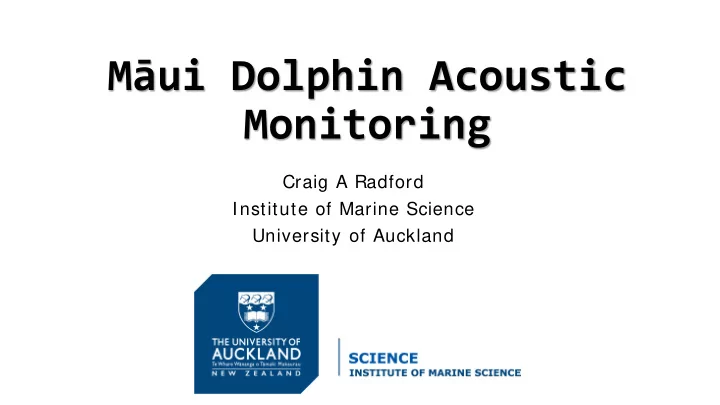

Māui Dolphin Acoustic Monitoring Craig A Radford Institute of Marine Science University of Auckland
Background • Hector’s dolphins venture further offshore than previously thought • Current protection measures use range of offshore limits depending on the activity being controlled • Uncertainty surrounding the risk outside this area because the distribution of Māui’s is not well-known
Key Question • How far do Māui’s venture offshore?
Deployment Site • C-POD’s and ST’s • Click Detecting ST at M2 • Deployed 28/ 06/ 2018 • Retrieved M2-8 15/ 11/ 2018 • Lost M1 & M9 • M8 malfunctioned • Additional data from Hamilton’s Gap, New Plymouth & Whanganui Hupman & Goetz 2017
Processing & Assumptions • Using C-POD KERNO classifier – detects click trains • Narrow Band High Frequency (NBHF) • Verify by manually scrolling through the detections • That all NBHF detections are due to Māui’s
Summary of NBHF Detections CPOD/ Location July August Septem ber 2 0 1 7 October 2 0 1 7 Novem ber 2 0 1 7 2 0 1 7 2 0 1 7 M1 - - - - - M2 64 17 21 66 26 M3 6 0 6 22 5 M4 0 0 0 2 2 M5 0 0 0 0 0 M6 0 0 0 0 0 M7 0 0 0 - - M8 - - - - - M9 - - - - -
Temporal Distribution of Detections
Site: M2
Site: M3
Site: M4
Hamilton’s Gap
Distribution Based on Acoustic Detections Decreasing detection rates
Limitations • Assumption that all NBHF sounds are Māui’s • Off-axis C-POD data potentially could be unreliable • Background noise effects detection rates
ST Comparisons Sound Trap Click Detections C-POD Click Detections 1200 140 500 140 120 120 1000 400 Instensity (dB re 1uPa) 100 100 Intensity (dB re 1uPa) 800 Number of Clicks Number of Clicks 300 80 80 600 60 60 200 400 40 40 100 200 20 20 0 0 0 0 July 2017 July 2017
ST Comparisons • Difficult to make direct comparisons because of the different outputs • Background noise affects the detections • Ocean Instruments developing a click train detector and software to analyse the data in • Benefit of the ST over the C-POD is that you can get sound data at the same time
Acknowledgements • Whitney Nelson – summer student who did the analysis • NIWA deploying and retrieving C-POD’s and ST’s
Recommend
More recommend